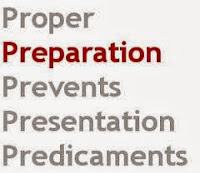So much of what we do at Toastmasters can be summarised under the
heading of Learning by Doing. However, it makes sense that one can't really Do
unless one is first shown How to Do.
For this reason then, I am going to publish the bones of a recent speech
I did on the subject of Speech Construction. It can all be broken down into
Ten basic steps:
- Step 1: The Idea
Select a topic on which you can speak with
conviction, authority and enthusiasm.
- Step 2: The Central Theme
Jot down one or two sentences describing what you
want the audience to learn from your speech. Use this central theme as a guide
during the rest of your speech development, to avoid getting side-tracked.
- Step 3: The Purpose
Decide what you want to achieve through your
speech. For example, do want to inform or educate or entertain the audience, or
do you want to motivate or inspire the audience to action?
- Step 4: The Broad Outline
Introduction; 2 or 3 basic points of the Body; Conclusion
Select one or two phrases describing the content or
approach of each part of the speech. Each part must support your central theme.
Many studies
have shown that people can remember very few of the facts or items of
information that speakers convey. You only need to make 2 or 3 points to have
your talk be successful.
- Step 5: Formulate Your Opening
and Conclusion
The purpose
of the introduction is:
-
To grip and
hold the attention of the audience
-
To motivate
the audience to listen to the speaker’s message
-
To give the audience
some indication what the speaker is going to talk about, and why
Some possible
effective openings:
-
Ask a
question
-
Refer to a
recent event of interest
-
Begin with
an unusual statement or question
-
Refer
directly to the problem
-
Show a
picture, diagram or object
-
Announce
clearly the main points you want to make
Beware of the joke or personal story in your introduction
The introduction should take up about 10 % of the
total time of your presentation.
An effective conclusion draws all points
presented in the speech together, and focuses attention and emphasis on the
central theme.
No new information should be introduced in the
conclusion of a speech.
You might try the following:
-
Summarise
the main points of your presentation
-
Restate your
opening
-
Use a quotation,
statistics, an analogy, or a vivid illustration to epitomize the whole idea
-
End with a
direct appeal for support or action
-
Give your
audience something challenging to think about
- Step 6: Filling in the Details
Concentrating on details right away causes us to
lose direction, and we could end up with a mass of detail rather than a focused
speech.
As you add detail, ask yourself “What is it about
this that is important to supporting my central theme and purpose?”
Do the research that is required to add facts,
figures, examples and quotations to substantiate your content. (Remember that
the source of quotations, statistics and even pictures must be acknowledged.)
Decide on the audio-visual aids you require, e.g.
music, flip chart, overhead transparencies or data projector.
The body of your speech should take up about 85 %
of the presentation time.
- Step 7: Give Your Speech a Title
When your speech title is announced immediately
before your presentation, it should have the same effect on your listeners as a
newspaper headline has on its readers. They will decide immediately whether
they are interested; whether they want to know more; or whether the topic does
not interest them at all.
Also,
prepare your audio-visual aids
Check for purpose. Does
everything still work towards achieving your objectives? Imagine your audience as you
rehearse.
 - Step 10: Make Keyword Notes for use during the actual
presentation
- Step 10: Make Keyword Notes for use during the actual
presentation
The opening and closing sentences should be
written out in full, and memorized.
Any quotations should also be written out in
full. This will prevent you from
misquoting.
Until next time
Ricky Woods



